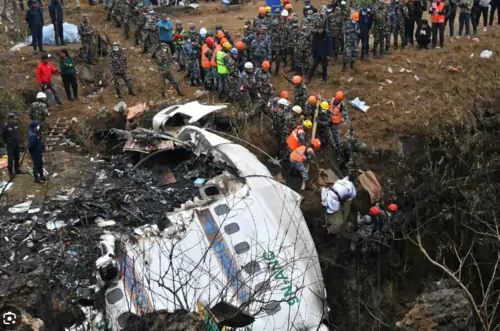
50 Years of Nepal Plane Crashes: Shocking Disasters Unveiled
ADVERTISEMENT-

Introduction
Nepal’s aviation history is marked by breathtaking landscapes, unique geographical challenges, and a series of tragic plane crashes that have left a lasting impact on the country’s aviation safety measures.
Studying these incidents is crucial for understanding and improving aviation safety not only in Nepal but also in similarly challenging environments worldwide.
This article delves into 50 years of plane crashes in Nepal, unveiling the shocking disasters, their causes, and the advancements made in aviation safety as a result.
Geographical Challenges
Nepal’s topography, characterized by the towering Himalayas and deep valleys, poses significant challenges to aviation. The country’s varied weather patterns, including sudden storms and heavy fog, further complicate flight operations. These geographical and climatic factors have a profound impact on aviation safety, making Nepal one of the most challenging places to fly in the world.
Historical Context
Early Aviation in Nepal
Aviation in Nepal began in the mid-20th century with the establishment of the country’s first airline, Nepal Airlines, in 1958. Early flights were fraught with challenges, including limited infrastructure and the need to navigate treacherous terrain.
Key Milestones in Aviation Development
Over the decades, Nepal’s aviation sector has grown significantly, with the introduction of new airlines, the expansion of airports, and the adoption of modern aircraft. However, this growth has also been accompanied by a series of tragic plane crashes that have highlighted the ongoing challenges faced by the industry.
-ADVERTISEMENT-

Major Plane Crashes (1974-2024)
1974: PIA Flight 707
On November 9, 1974, PIA Flight 707, en route from Karachi to London, crashed into a hillside near Kathmandu, killing all 167 passengers and crew on board. The crash was attributed to pilot error and poor weather conditions.
1992: Thai Airways International Flight 311
Thai Airways International Flight 311 crashed into a mountain north of Kathmandu on July 31, 1992, due to pilot error and confusion caused by poor weather, resulting in the deaths of all 113 people on board.
1992: Pakistan International Airlines Flight 268
Just two months after the Thai Airways crash, Pakistan International Airlines Flight 268 crashed into a hill while approaching Kathmandu, killing all 167 passengers and crew. The crash was caused by a combination of pilot error and inadequate approach procedures.
2002: Shangri-La Air Flight 703
Shangri-La Air Flight 703 crashed near Pokhara on August 22, 2002, due to poor visibility and pilot error, resulting in 18 fatalities.
2012: Sita Air Flight 601
Sita Air Flight 601 crashed shortly after takeoff from Kathmandu on September 28, 2012, due to engine failure and pilot error, killing 19 people.
2014: Nepal Airlines Flight 183
Nepal Airlines Flight 183 crashed into a mountainside in bad weather on February 16, 2014, killing all 18 people on board. The crash was attributed to poor weather conditions and pilot error.
2018: US-Bangla Airlines Flight 211
US-Bangla Airlines Flight 211 crashed while landing at Tribhuvan International Airport on March 12, 2018, due to a miscommunication between the pilot and air traffic control, resulting in 51 fatalities.
2023: Yeti Airlines Flight 691
Yeti Airlines Flight 691 crashed into a gorge near Pokhara International Airport on January 15, 2023, due to a sudden loss of control by the pilot, killing all 72 people on board.
Learn More about👉👉 Nepal Plane Crash: Nepal’s Deadliest Plane Disasters in Last 50 Years That Shocked the World
Causes of Plane Crashes
Pilot Error
Pilot error has been a significant cause of many plane crashes in Nepal. Factors such as miscommunication, poor decision-making, and lack of experience in navigating difficult terrain have contributed to several accidents.
Mechanical Failure
Mechanical failures, often exacerbated by the challenging operating conditions, have also played a role in many crashes. Issues with aircraft maintenance and the use of older planes have been recurring problems.
Weather Conditions
Nepal’s unpredictable weather, including sudden storms, heavy fog, and strong winds, has been a major factor in many aviation disasters. Poor weather can lead to reduced visibility and difficult flying conditions, increasing the risk of accidents.
Human Factors
Human factors, including fatigue, stress, and inadequate training, have also contributed to plane crashes. The high-stress environment of flying in Nepal’s challenging conditions can lead to mistakes and accidents.
Impact on Aviation Policies
Changes in Safety Regulations
In response to the numerous plane crashes, Nepal Air Industry has implemented stricter safety regulations. These include more rigorous training and certification requirements for pilots and improved maintenance standards for aircraft.
Introduction of New Technologies
Advancements in technology have also played a role in improving aviation safety. The introduction of modern aircraft with better navigation systems and more reliable engines has helped reduce the risk of accidents.
Training and Certification Improvements
Enhancements in pilot training programs and more stringent certification processes have been crucial in addressing the human factors that contribute to plane crashes. These improvements aim to better prepare pilots for the unique challenges of flying in Nepal.
-ADVERTISEMENT-

Personal Stories and Survivor Accounts
Interviews with Survivors
Interviews with survivors of plane crashes provide a personal perspective on the tragedies. Their stories of survival and the aftermath of the crashes highlight the human impact of these disasters.
Accounts from Families of Victims
Families of victims share their experiences of loss and the long-term effects of plane crashes on their lives. Their accounts underscore the importance of ongoing efforts to improve aviation safety.
Expert Insights
Analysis from Aviation Experts
Aviation experts provide insights into the causes of plane crashes and the effectiveness of safety measures. Their analysis helps identify areas for improvement and highlights the progress made in aviation safety.
Comments from Safety Regulators
Safety regulators offer their perspectives on the changes in aviation policies and the challenges of enforcing safety standards. Their comments shed light on the regulatory landscape and its impact on aviation safety.
Advancements in Aviation Safety
Modern Aircraft Technology
The adoption of modern aircraft with advanced navigation and safety systems has significantly improved aviation safety. These technologies help pilots navigate challenging terrain and adverse weather conditions more effectively.
Improved Weather Forecasting
Advances in weather forecasting have also contributed to safer flying conditions. Better predictions of weather patterns allow pilots to plan routes that avoid dangerous conditions.
Enhanced Training Programs
Enhanced training programs for pilots and maintenance personnel focus on preparing them for the specific challenges of flying in Nepal. These programs include simulations of difficult flying conditions and advanced navigation techniques.
Comparative Analysis with Global Aviation
Comparing Nepal’s Aviation Safety with Other Countries
A comparison of Nepal’s aviation safety record with other countries reveals the unique challenges faced by Nepal. While the number of crashes is higher, the steps taken to improve safety are aligned with global best practices.
Lessons Learned from Global Aviation Practices
Learning from global aviation practices, Nepal has adopted several measures that have proven effective in other countries. These include stricter safety regulations, better training programs, and the adoption of new technologies.
Challenges and Future Prospects
Ongoing Challenges in Nepalese Aviation
Despite the advancements, Nepalese aviation continues to face challenges such as difficult terrain, unpredictable weather, and limited infrastructure. Addressing these issues requires ongoing efforts and investment.
Future Safety Initiatives
Future safety initiatives include further improvements in technology, enhanced training programs, and continued efforts to strengthen regulatory oversight. These initiatives aim to reduce the risk of plane crashes and improve overall aviation safety.
-ADVERTISEMENT-

Frequently Asked Questions (FAQs)
What are the primary causes of plane crashes in Nepal?
The primary causes include pilot error, mechanical failures, adverse weather conditions, and human factors. Each crash often involves a combination of these elements.
How has Nepal improved aviation safety over the years?
Nepal has improved aviation safety through stricter regulations, advanced technology, and enhanced pilot training. These measures aim to address the challenges posed by the country’s unique geographical and weather conditions.
What role do weather conditions play in aviation accidents in Nepal?
Weather conditions significantly impact aviation safety in Nepal. The country’s unpredictable weather, including fog and heavy rains, can severely reduce visibility and create hazardous flying conditions.
How do Nepalese aviation safety practices compare globally?
Nepal’s aviation safety practices have been improving but still face challenges compared to global standards. Lessons from other countries can help Nepal enhance its safety measures and practices.
What are the prospects for aviation safety in Nepal?
Prospects include the adoption of new technologies, further improvements in training programs, and increased international collaboration to enhance overall safety and reduce the risk of accidents.
This comprehensive overview of Nepal’s aviation history and safety challenges underscores the critical importance of continued improvements and vigilance.
By learning from past tragedies and implementing effective measures, Nepal can work towards a safer and more reliable aviation future.
Conclusion
The history of plane crashes in Nepal reveals a sobering narrative of challenges and progress. Each tragic incident has prompted significant advancements in aviation safety, driven by a commitment to learning from past mistakes and addressing the unique difficulties posed by Nepal’s geography and weather conditions.
As Nepal continues to improve its aviation infrastructure, adopt new technologies, and enhance training programs, the goal remains clear: to prevent future disasters and ensure the safety of all who fly.
By embracing global best practices and fostering ongoing innovation, Nepal can pave the way for a more secure and reliable aviation future, honoring the lives lost and striving to protect those who travel through its skies.
You May Also Like
- Join Now: SlotVIP Register Tips for Instant Bonuses!
- Step-by-Step SlotVIP Login: Your Gateway to VIP Slot
- Your Guide to SlotVIP Download: Fast Track to Winning!
- SlotVIP Deposit Tips for Instant Bonuses! Register Now
- Apk download for the SlotVIP App on iOS and Android
- Exclusive Access Awaits SlotVIP Withdrawal Today!
- SlotVIP Bonus: 🎰 Your Ticket to VIP Slot Rewards!
- Axiebet88 Get Exclusive 888 + 5000 Limited Olympic Bonus
- Bini Cherry on Top MV Hits 2 Million Views in Record Time
- Cinemalaya’s 20th Anniversary: Filipino Filmmakers Roar
- Exclusive: What Led to Kawhi Leonard’s Removal from Team USA
- Cathay Pacific: A 76-Year-Old Injured by Falling Luggage
- Palarong Pambansa 2024 in Cebu City: Celebrating Sports
- TikTokio.com: Caution Advised for Third-Party Risks
- May 2024 CPALE Results Released in Three Days 📊🎉
- Discover the Excitement at 555 BMW Casino | Play Now
- AF777 Casino: Play Now and Get 777 + 150% Bonus–Play Now
- Hellspin Casino – ₱3,000 Weekly Bonus | Register Now
- Unlock Mega Swerte Free 100 Register + 50 Download Bonus!
- ScatterWin Casino – Ultimate Online Gaming Experience
- Freespin888 🎰: Free Spins & ₱888 Bonus – Play Now! 🎉
We Also Recommend
- Mega Swerte Register | Get a Free 888 Welcome Bonus
- Mega Swerte Casino: Top 10 Games You Must Try Today
- Mega Swerte Casino Login Get Free Exclusive Bonus – Play Now
- Mega Swerte – Free 888 Bonus When You Register Today!
- Mega Swerte Gaming: Get an Instant 888 Bonus Today! Play Now
- Mega Swerte Review: Claim Your Bonus Up to 888 Now
- Mega Swerte Free 100 Register + 50 Download Bonus 🎰💸📲
- Discover Mega Swerte Download Benefits | Get a Free 50 bonus
- Jk4 Slot Login
- 9kslot
- Ra777 Casino Login Register App

Rihanna Cruz, is a wordsmith seasoned in three years of online gaming journalism, captivates readers with her passion-fueled articles. She translates complex mechanics into engaging narratives, offering insightful perspectives on mobile RPGs, esports psychology, and more.




